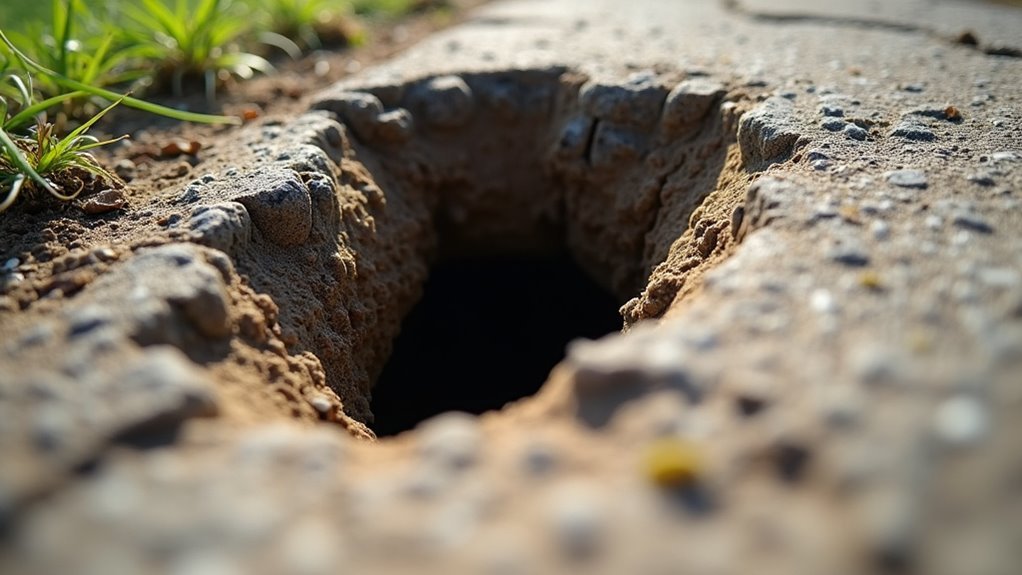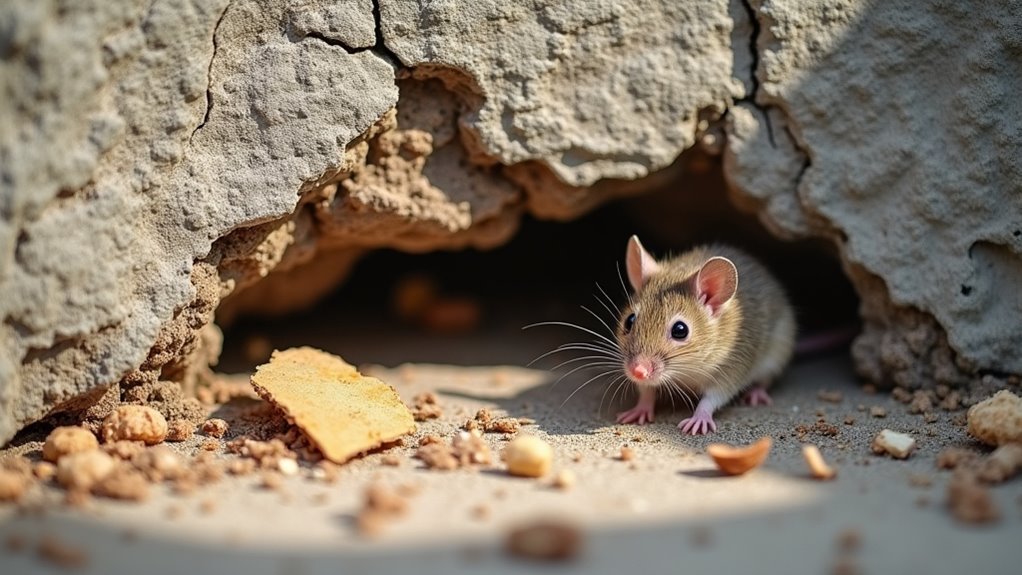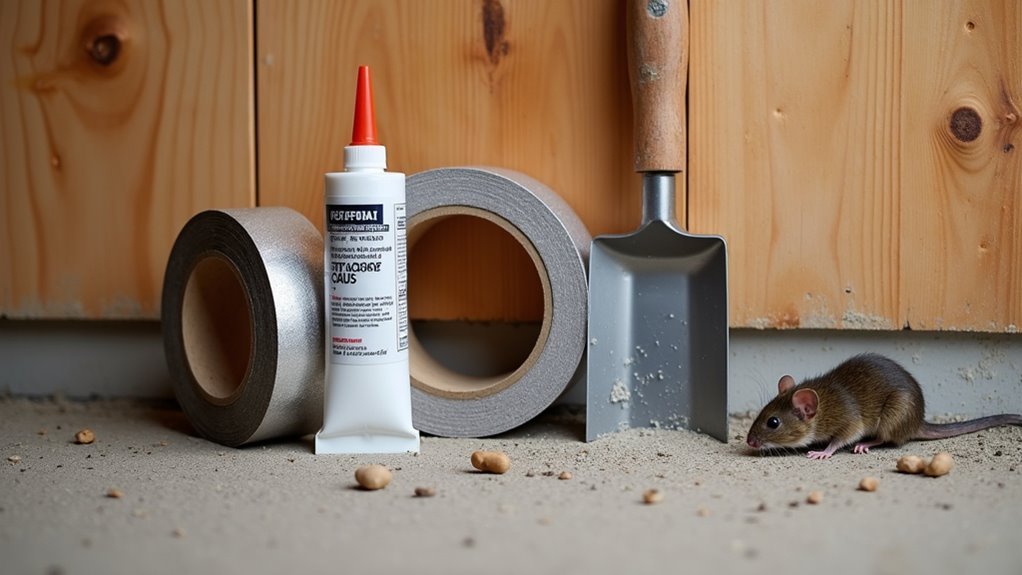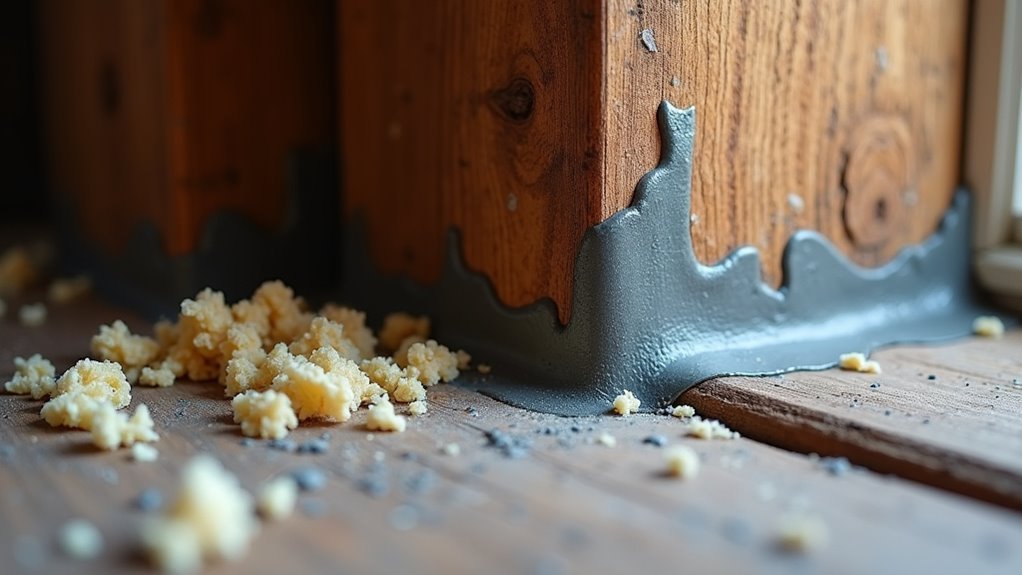You should seal foundation gaps against mice because these tiny openings serve as primary entry points for rodents who can squeeze through spaces as small as a nickel. Unsealed gaps expose your family to serious health risks including hantavirus, salmonella, and respiratory allergens from mouse droppings and urine. Mice also cause extensive property damage by gnawing through insulation, electrical wires, and wooden structures, creating fire hazards and costly repairs. Discover thorough sealing strategies below.
How Mice Enter Through Foundation Gaps

When you’re dealing with a mouse problem, understanding their entry points is essential since these persistent rodents can squeeze through foundation gaps as small as a nickel.
Mice commonly exploit cracks in foundation walls, openings around utility lines, and spaces in old stone walls with loose rubble. Construction gaps around air conditioning units and water pipes create direct pathways into your home.
Weep holes in brick walls, though designed for ventilation, become unintended access points when left unprotected. You’ll also find that mice can gnaw through wood and siding materials, creating additional vulnerabilities.
These gaps in the foundation multiply over time, making it vital to seal your house properly before infestations occur.
Health Risks Associated With Mouse Infestations
Beyond the structural damage and nuisance factor, mouse infestations pose serious health threats that can affect your family’s well-being.
These rodents carry dangerous diseases like hantavirus, salmonella, and leptospirosis, which they transmit through their droppings and urine. When mice contaminate your food surfaces, you’re exposed to serious foodborne illnesses that can make your family sick.
The health risks don’t stop there. Mouse allergens from their droppings, urine, and fur can trigger asthma attacks and worsen existing allergies.
Additionally, mice bring secondary pests like fleas and ticks into your home, creating even more health complications.
The CDC strongly recommends controlling mouse populations to maintain a safe living environment.
You can greatly reduce these health risks when you fill the gaps in your foundation, preventing mice from entering your home in the first place.
Property Damage Caused by Foundation-Dwelling Mice

While health concerns grab attention, the property damage mice inflict can devastate your home’s structure and your wallet.
These persistent rodents gnaw through insulation, drywall, and wooden structures, potentially compromising your home’s structural integrity. They’ll chew electrical wires, creating serious fire hazards from exposed wiring that could burn down your entire property.
Mice contaminate surfaces with droppings and urine, requiring expensive professional cleanup. They’ll damage baseboards and finishing materials while creating new gaps or cracks that invite more infestations. Each unsealed opening becomes an entry point for additional mice.
Mice leave waste everywhere, forcing homeowners into expensive cleanups while their destructive chewing creates more entry points for future invasions.
With their rapid reproductive rate, a small mouse problem quickly escalates into major property damage.
What starts as minor gnaw marks becomes costly repairs throughout your home’s foundation and beyond.
Why Foundation Gaps Are Primary Entry Points
Foundation gaps serve as superhighways for mice because these rodents can squeeze through openings as small as a nickel.
You’ll find that cracks and crevices in foundation walls become critical entry points that require immediate attention. If you’re living in a historic home with old stone walls, you’re particularly vulnerable since rubble between stones creates perfect hiding spots and access routes.
Don’t overlook construction gaps around pipes and utility lines – these often-forgotten areas provide direct pathways into your home.
Once mice discover these foundation gaps, they’ll follow scent trails from previous infestations, making re-infestation highly likely.
Every unsealed opening becomes an invitation for these persistent pests to establish residence in your property.
Materials Needed for Effective Foundation Sealing

You’ll need specific materials and tools to create an effective barrier that prevents mice from entering through your foundation gaps.
Professional-grade sealing products offer superior durability and resistance compared to basic household alternatives.
Having the right application tools guarantees you can properly install these materials for long-lasting protection.
Essential Sealing Materials
Success in sealing foundation gaps depends on choosing the right materials for each type of opening you’ll encounter. Steel wool works best for small cracks and holes since mice can’t chew through it effectively.
You’ll want silicone caulk for larger gaps around doors, windows, and foundation walls because it’s flexible and rodent-resistant.
Metal screens are essential for covering exhaust fans and vents while maintaining proper airflow.
For masonry gaps, use mortar patching compounds like QUIKRETE that offer excellent outdoor durability and strong adhesion.
Expanding foam fills larger voids quickly, but it’s not chew-proof on its own. Always combine it with steel wool or metal coverings for maximum protection against determined rodents seeking entry points.
Professional Grade Products
Professional-grade sealing products offer superior performance and longevity compared to basic hardware store options. When you’re serious about keeping mice out, invest in specialized materials designed for long-term rodent exclusion.
QUIKRETE mortar patching compound provides professional-grade adhesion and weather resistance for sealing masonry gaps and cracks. You’ll get stronger bonds that withstand freeze-thaw cycles and seasonal movement.
For ridge vents, Ridge-Guard metal products create impenetrable barriers against mice entry. These professional-grade products secure vulnerable roof areas effectively.
Xcluder fill fabric combines stainless steel and poly construction, offering chew-resistant properties that outlast standard materials. You can trust it for gaps and cracks where rodents typically gnaw through inferior products.
Silicone caulk with chew-resistant formulation maintains flexibility while blocking access points permanently.
Application Tool Requirements
While professional-grade materials form the backbone of effective rodent exclusion, you’ll need the right application tool requirements to guarantee proper installation and long-lasting results.
These essential tools guarantee you can properly prepare surfaces and apply sealing materials effectively.
Your toolkit should include:
- Caulking gun – Essential for applying sealants smoothly into cracks and gaps
- Putty knife – Necessary for spreading mortar compounds and smoothing surfaces
- Wire brush – Critical for cleaning debris from gaps before sealing
- Pressure washer or air compressor – Removes dirt and loose material for better adhesion
Having proper tools makes the difference between temporary patches and permanent solutions.
You can’t effectively Fix Cracks without quality application equipment that secures materials bond correctly to foundation surfaces.
Step-by-Step Foundation Gap Sealing Process
You’ll need to systematically work through three essential phases to effectively seal your foundation against mice.
Start by identifying all potential entry points around your foundation’s perimeter.
Then thoroughly clean and prepare these areas for ideal sealing material adhesion.
Finally, apply the appropriate sealing materials based on the size and type of gaps you’ve discovered.
Identify Entry Points
Before sealing any gaps, you must thoroughly inspect your foundation to locate every potential entry point where mice might squeeze through.
Remember, mice can fit through openings as small as a nickel, making even tiny cracks significant threats.
Follow this systematic approach to identify all gaps:
- Examine foundation walls closely – Focus on old stone walls and construction joints where gaps commonly develop.
- Check corners and junctions – Look where different materials meet, as these areas often separate over time.
- Inspect after weather changes – Seasonal shifts and extreme weather can create new openings.
- Document each location – Mark or photograph every gap you find for your sealing plan.
Pay special attention to areas around utility penetrations, where pipes and cables enter your home through the foundation.
Clean and Prepare
Once you’ve mapped out all the entry points, proper preparation becomes the foundation of effective sealing.
You’ll need to clean and prepare each gap thoroughly before applying any sealing materials. Start by removing all dust and debris using air pressure or a pressure washer to guarantee proper adhesion.
Next, inspect existing mortar or cement in these areas—deteriorated materials must be removed or repaired first. Allow the foundation to dry completely after cleaning, as moisture can compromise sealing effectiveness and create future problems.
Choose appropriate materials like QUIKRETE mortar patching compound designed for masonry repairs.
When you seal foundation gaps properly, following manufacturer’s instructions guarantees you’ll fill every opening effectively, preventing mice from entering your home.
Apply Sealing Materials
Three essential steps form the core of effective foundation gap sealing, starting with proper material application techniques.
You’ll need to select appropriate materials based on gap size and location.
Here’s your step-by-step approach:
- Small gaps: Pack steel wool tightly into openings, then apply silicone caulk over the surface for chewing resistance.
- Medium cracks in walls: Use QUIKRETE mortar patching compound designed for masonry repairs and outdoor durability.
- Large openings: Insert timber pieces or L-shaped metal trims, then seal edges with expanding foam or caulk.
- Final application: Apply sealant in smooth, continuous beads while ensuring complete coverage without air bubbles.
Work systematically from bottom to top, allowing each application to cure properly before moving to adjacent areas.
Common Foundation Areas That Require Sealing
While mice can squeeze through openings as small as a nickel, several specific foundation areas consistently provide them with easy access to your home. Foundation walls develop cracks over time that create perfect entry points. You’ll also find gaps around utility lines and pipes where they penetrate your foundation, offering direct pathways inside.
| Problem Area | Common Entry Points |
|---|---|
| Structural Elements | Foundation wall cracks, unsealed vinyl siding corners |
| Utility Penetrations | Gaps around pipes, utility lines, electrical conduits |
| Ventilation Features | Weep holes in brick, unsealed air bricks |
Don’t overlook connections near your foundation where different materials meet. Weep holes in brick structures and construction gaps require regular inspection. These vulnerable spots need immediate attention to maintain effective mouse prevention.
Signs Your Foundation Needs Mouse-Proofing
How can you tell if mice have already discovered weaknesses in your foundation? Several warning signs indicate your home’s foundation gaps need immediate mouse-proofing attention.
Watch for these key indicators:
- Visible foundation damage – Even gaps as small as a nickel can serve as entry points for determined mice.
- Evidence of previous activity – Mouse droppings or gnawed food packaging suggest unsealed entry points exist.
- Cluttered exterior conditions – Debris and overgrown vegetation near your foundation attract mice and signal vulnerability.
- Unusual sounds – Scratching noises in walls or ceilings indicate mice have already found foundation access points.
Additionally, inspect for moisture damage around your foundation, as compromised areas increase your home’s vulnerability to infestations and require prompt mouse-proofing measures.
Cost Comparison: DIY Vs Professional Foundation Sealing
When deciding between DIY and professional foundation sealing, you’ll face a significant cost comparison that reflects more than just upfront expenses.
DIY materials like steel wool, caulk, and metal screens cost $5-$20 each, while professional services range from $200-$600 depending on infestation severity.
However, DIY sealing presents challenges. You’ll need to access difficult areas like roofs and crawl spaces, which can be time-consuming and risky.
Professional pest control companies offer extensive solutions with warranties, ensuring thorough exclusion and long-term effectiveness.
While DIY appears cheaper initially, inadequate sealing can lead to recurring infestations, resulting in higher long-term costs for repeated pest control and property damage repairs.
Professionals provide expertise and guarantees that DIY methods can’t match.
Preventing Future Foundation Gap Formation
Once you’ve sealed existing foundation gaps, implementing a proactive maintenance strategy becomes essential for preventing new entry points from developing.
Preventing future foundation gap formation requires consistent attention to your home’s exterior conditions and structural integrity.
Here’s how you’ll protect your home from future gaps:
- Schedule regular foundation inspections to identify early signs of cracks or wear before they expand into mouse-sized openings.
- Maintain proper landscaping by trimming overgrown bushes and keeping mulch at least 18 inches from your foundation walls.
- Use high-quality sealing materials like silicone caulk and steel wool for any minor cracks you discover during inspections.
- Conduct seasonal cleaning around your foundation, removing debris and clutter that creates nesting sites and potential gap formation.
Long-Term Benefits of Sealed Foundation Barriers
You’ll achieve permanent rodent exclusion when you seal foundation gaps, creating an impenetrable barrier that stops mice from entering your home indefinitely.
This one-time investment provides cost-effective property protection by eliminating recurring pest control expenses and preventing expensive structural damage from gnawing and nesting.
Your sealed foundation becomes a reliable defense system that protects both your wallet and your home’s integrity for years to come.
Permanent Rodent Exclusion
Although many homeowners focus on quick fixes when dealing with rodent problems, sealing foundation gaps creates a permanent barrier that transforms your approach from reactive pest control to proactive prevention.
When you seal foundation gaps effectively, you’ll keep mice out indefinitely rather than constantly battling new invasions.
This permanent exclusion strategy delivers four critical advantages:
- Eliminates entry points that mice use to access your home’s interior spaces
- Breaks scent trails that attract additional rodents to your property
- Prevents rapid reproduction by blocking access to potential nesting areas
- Protects structural integrity from ongoing damage to insulation and electrical systems
You’ll save considerable time and money by avoiding repeated pest control treatments and costly repairs from mouse damage.
Cost-Effective Property Protection
When you invest $5 to $20 in quality sealing materials, you’re protecting yourself against pest control bills that typically range from $200 to $600 per treatment.
This cost-effective approach delivers exceptional property protection by creating permanent barriers that prevent recurring infestations.
You’ll avoid expensive repairs from mice damage, including chewed electrical wiring and destroyed insulation that can cost hundreds or thousands to fix.
Unlike temporary solutions that require repeated applications, properly sealed foundation gaps provide long-term protection that saves you money year after year.
This proactive investment also protects your family’s health by eliminating disease transmission risks from mouse droppings and urine.
You’ll maintain a cleaner living environment while enhancing your property’s value through effective pest prevention.
Frequently Asked Questions
How to Seal Foundation to Keep Mice Out?
Inspect your foundation walls for gaps and cracks. Clean debris, then fill small openings with steel wool and silicone caulk. Use metal mesh for larger holes and apply mortar compound for durable sealing.
How Do You Seal Gaps to Keep Mice Away?
You’ll seal gaps by stuffing steel wool into small openings, then covering with silicone caulk. For larger gaps, use metal trim or timber inserts, and cover vents with wire mesh to block mice completely.
Will Sealant Keep Mice Out?
Yes, sealant will keep mice out when you properly apply professional-grade products to foundation gaps. You’ll create an effective barrier that blocks entry points and prevents mice from squeezing through small openings.
Can Mice Get in Through Foundation Cracks?
Mice can definitely enter your home through foundation cracks as small as 1/4 inch. They’ll squeeze through openings the size of a nickel, making even tiny foundation gaps potential entry points.
In Summary
You’ll protect your home’s health and structural integrity by sealing foundation gaps against mice. Don’t underestimate these small entry points – they’re highways for rodent infestations that’ll cost you more in damage and remediation than prevention. Whether you choose DIY methods or professional sealing, you’re investing in long-term peace of mind. Take action now to inspect your foundation, identify vulnerable areas, and create an effective barrier that’ll keep mice out permanently.





Leave a Reply